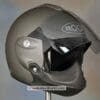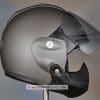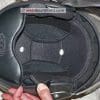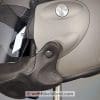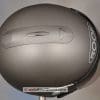The Rover is another unique helmet from ROOF.
It’s based on the ROOF Boxer, but the Rover is an open-face helmet with a twist: a “Rider Mask” can be attached across the front.
If you want to own something different, ROOF can surely oblige.
Here’s another new design from the folks that brought us the original ROOF Boxer, the new Boxer V; the ROOF RO10 LeMans and more.
The ROOF R05 Rover is — like all of the other ROOF helmets — unique, different and, well, like only something that could come from the minds of ROOF designers.
I can picture them, lying in bed at night, dreaming up new ideas for the next helmet, using reruns of The Jetsons as inspiration.
The Rover is apparently ROOF’s take on the SCHUBERTH J1, as near as I can tell. It’s based on the Boxer shell, but without the fold-down visor that can be flipped all the way back, which converts the Boxer to an open-face design.
The Rover’s signature feature is the “Rider Mask”; a soft foamy sort of rubbery mouthpiece that can be attached to the helmet.
The helmet can be worn with or without the Rider Mask, which is fastened to the helmet via screw on the right side of the helmet.
The mask covers the rider’s mouth and snaps on to the helmet on the left side.
It sounds like an interesting idea, but does it work? We’ll address that in a minute, but let’s first take a look at all of the Rover’s features.
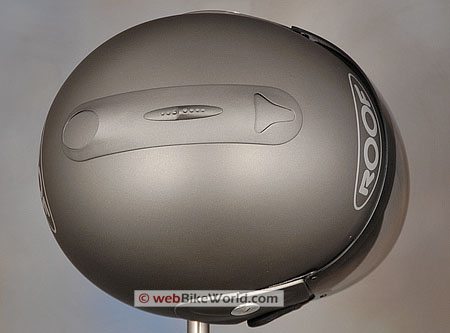
Roof Rover Paint and Finish
ROOF is what I might call a “boutique” helmet manufacturer. They’re a small company, located in the south of France, near Cannes and Antibes, and the helmets are produced in relatively low volumes.
Although some owners have told us that ROOF quality levels can be variable, we’ve had no problems with any of the ROOF helmets we’ve tried over the years.
Our experience indicates that the quality is about average when compared to other brands.
Our Rover has a dull gray metallic finish, which admittedly does look more industrial than artistic, but the paint is evenly applied with no noticeable faults.
The shell has a robust feel with no apparent flexing and everything seems well made, ready to take more abuse than a few other brands I could name.
The ROOF logos on the front and back of the helmet are actually a type of thin decal, but the letters appear to be painted on the helmet’s surface, and the logos have a matte finish to match the surface of the helmet.
Two small stickers have been applied on each side of the helmet which read “Fiberglass”, and there are two additional stickers on the rear of the helmet, one describes the helmet size and the other is an additional ROOF logo.
These stickers are made from a shiny clear vinyl which contrast with the Rover’s matte paint.
They are probably necessary to meet some European specification but — wink, wink — they can also be peeled off very easily with a fingernail, so I’ll guess that ROOF used this material to allow the owner to quickly remove what isn’t necessary. The helmet does look better without them!
Score: The Rover’s dull metal-colored paint probably doesn’t do it justice, but overall I’d rate the finish as Very Good.
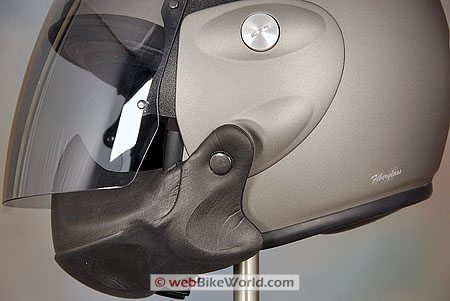
Roof Rover Face Shield
The ROOF Rover has a large, clear visor that is fitted to a rotating mechanism hidden by side plates on the helmet.
The visor rotates up and down about the same distance as the visor on a full-face helmet; that is, it does not rotate all the way to the back of the helmet like the Boxer’s visor.
The Rover’s visor does have the infinite adjustment system found on the Boxer however. The visor stays in place when it’s lifted via the friction caused by tightening the side plates, rather than the detents or notches found on most full-face helmets.
The visor offers plenty of visibility, whether the Rider Mask is used or not.
I have come to understand one reason for the popularity of open-face helmets because the visibility they afford is wonderful, making it so very easy to look down and see the instruments, the road and yes — even the speedometer mounted on top of the fuel tank.
The Rover is a revelation after wearing a full-face helmet, because I can see so much more of the road surface.
The visor on our helmet has a very slight dark tint. All of the Rover visors have also been treated with an anti-fog coating, which seems to work well based on a few very early morning rides.
Score: The visor seems sturdy; the amount of friction can be adjusted by tightening the screws on the side plates; it has an infinite adjustment and it provides a nice, wide, clear view.
The polycarbonate used in the visor is good quality and does not seem to have any unusual distortion patterns. I’m hoping the four studs that are used to attach the visor to the plastic rotating carrier will last. I give it a Very Good.
Venting and Air Flow
The Rover’s top venting system is identical to the vent found on the Boxer V. The original Boxer had no vents at all, so this is a definite improvement.
Because the Rover’s top vent is identical to the Boxer V, its description is also identical.
It consists of a raised bridge on top of the helmet; the front vent lets in air and the rear vent acts as an exhaust, theoretically pushing air down into the top of the helmet and releasing out the back.
The sliding switch on top opens or closes the vents simultaneously.
The switch is located in the center of the vent channel and it is easily located while riding and works well, but the vent “doors” open only about a couple of millimeters wide.
I wonder if the system would be more effective if the vent doors opened wider?
As is usually the case with an open-face helmet, it’s hard to notice a difference when the top vents are open or closed because the open-face design naturally directs a good volume of air on to the rider’s face.
I can notice a slight increase in noise when the top vent is open, but overall, it’s not bad.
Score: The open-face design provides good air flow if the Rider Mask isn’t used and the combination of the open front and top vent provides decent air flow when the Rider Mask is installed. I’ll give it a rating of Good.
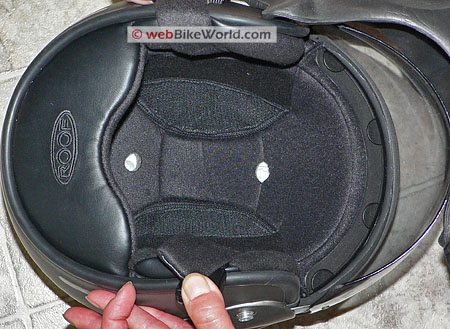
Internal Shape, Helmet Liner and Fit
The ROOF Rover has what I’d classify as a round internal fit. The helmet shown here is a size large and based on this example, I’d say that the helmet runs about 1/2 size large, so choose accordingly.
The removable liner has a wide band of material located towards the top, and when I slide the helmet on, the top of my head fits into the circle defined by this band.
It’s not uncomfortable, but it is different. It helps to keep the helmet firmly in place, but I do notice that it can get hot underneath the band in warm weather.
The band also defines the internal shape, so I have a feeling that the Rover is a helmet that will either fit or it won’t, and if the rider’s head shape isn’t compatible, there’s not much leeway.
The liner is relatively comfortable but thin on the sides. Score: I’ll give the liner a Good rating.
For more information on choosing and fitting a motorcycle helmet, visit our Motorcycle Helmet FAQ page, which also has a discussion on head shapes.
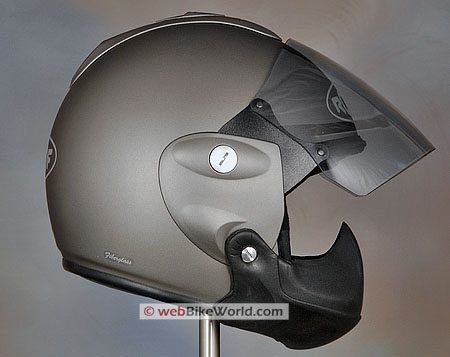
The Roof Rover Rider Mask
This feature distinguishes the Rover from just about any other motorcycle helmet available. A version of the Mask has been used before though, on the ROOF Bumper helmet.
The Rider Mask is a face mask made from some type of soft foam. It comes as an accessory in the helmet box and its installation is optional.
When fitted, it is secured on one side by the screw that tightens the right side panel and it fits across the rider’s face and secures to the left side of the helmet with a metal snap.
It has minimal vertical adjustment and no horizontal adjustment.
The Rider Mask fit very tightly across my face, making it slightly difficult to snap it shut. When closed, it fits right up against my mouth and chin — there’s not much room inside.
The Mask is not perforated and the back side is not lined, so my breath turns quickly to moisture against its surface, but this gets a little better once I get underway and the bike reaches 20MPH or so, where minimal air circulation lightens things up a bit.
The Rider Mask does serve to block the cold morning air, but it might work better if it was perforated, had some sort of a vent or if the back side was covered with some type of fabric.
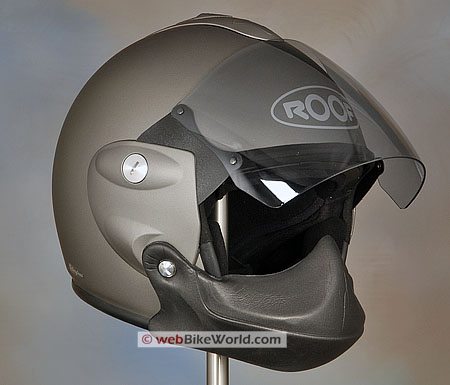
Helmet Weight
Our ROOF Rover in size large, with the Rider Mask attached, weighs 1525 grams, or 3 lbs., 5-3/4 oz. This is about average for an open-face, 3/4-length helmet.
The Rover has a snug fit as a result of the internal fabric band, and it doesn’t seem to be affected by lift or crosswinds.
For more information, see the wBW Motorcycle Helmet Weights page for a chart comparing the VR-3 with the other helmets we’ve reviewed.
Noise Levels
The Rover is actually fairly quiet for a 3/4-length open-face helmet.
With the Rider Mask installed, the helmet visor fits over the top and along the sides with a small gap. With the Rider Mask removed, the helmet still seems relatively quiet as open helmets go.
The top vent can sometimes add a slight whistling noise, but it’s not objectionable.
Score: I’ll give the Rover’s noise control a Good rating.
Remember that we always wear correctly fitted, high quality earplugs and an extra helmet liner when riding, and we strongly recommend that you always wear hearing protection also.
See the wBW Earplugs and Hearing Protection page for more information on choosing and wearing earplugs.
Miscellaneous
The Rover meets ECE 22.05 safety standards but is not DOT or Snell approved.
It is currently not sold in the U.S.A. but can usually be ordered through UK dealerships who are willing to ship to the U.S.A. (but watch out for the weak dollar exchange rate and high shipping costs).
The chin strap is not a D-ring, but uses the same attachment found on the Boxer V, a relatively complicated release system that must be properly adjusted for the individual rider before the first use. It seems easier to use on the Rover, probably because of its open-face design.
Conclusion
The ROOF Rover is a unique motorcycle helmet. Other than the Rider Mask, the Rover is actually one of the tamer ROOF designs, thus it should be of interest to anyone looking for an open-face helmet but with a unique look and design.
| wBW Review: ROOF Rover | |
|---|---|
| Available From: ROOF (France) | List Price (2007): £159 |
| Colors: Black, White, Silver, Matte Steel. Sizes: XS to 2XL |
Made In: France |
| More: ECE 22.05 standard only. | Review Date: June 2007 |
|
Rating Scale is subjective: Unacceptable, Poor, Neutral, Very Good, Excellent, Outstanding.
|
|
Owner Comments and Feedback
See details on submitting comments.


